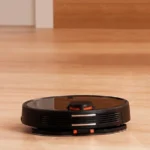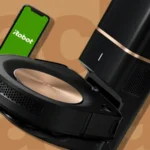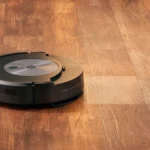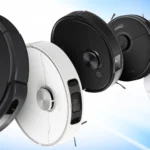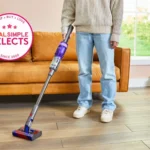Imagine finally setting aside some time for cleaning and realizing your vacuum cleaner is not up to par. The frustration of not being able to get your floors as clean as you want them can be overwhelming. That’s where an upright vacuum cleaner comes in handy. With its powerful suction and efficient cleaning performance, it’s the perfect tool to get the job done quickly and effectively. In this article, we’ll explore the advantages of using an upright vacuum cleaner, factors to consider when choosing one, as well as tips for getting the most out of your vacuuming experience. So sit back, relax, and let’s dive into the world of upright vacuum cleaners.
Advantages of Using an Upright Vacuum Cleaner
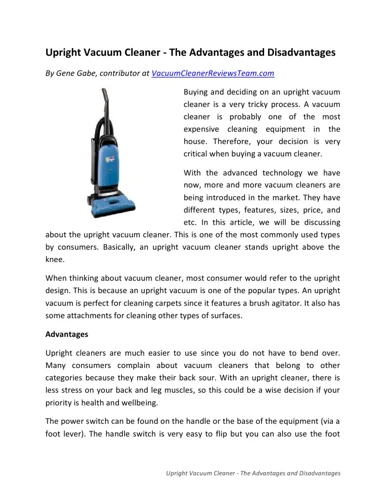
Maintaining a clean and tidy home can be challenging, but with the right tools, the task becomes much easier. One such tool is an upright vacuum cleaner, which provides numerous benefits over other types of vacuums. Whether you have carpeted or hard floors, an upright vacuum can help keep your home looking its best. In this section, we will explore the various advantages of using an upright vacuum cleaner and how it can make your cleaning routine more efficient. Plus, if you’re interested in finding the best upright vacuum for your home, check out our recommendations here: best-upright-vacuum-for-home.
1. Ease of Use
When it comes to cleaning, most people prefer using an upright vacuum cleaner. This is because of the numerous advantages it provides. One of the major advantages of using an upright vacuum cleaner is its ease of use.
| Advantages of an Upright Vacuum Cleaner | Disadvantages of an Upright Vacuum Cleaner |
|---|---|
| Designed with a comfortable handle grip that is easy to hold onto while cleaning. | Can be heavy and difficult to maneuver, making it tedious for people with back problems. |
| Typically has a larger dustbin capacity, reducing the need for frequent emptying of the bin. | Difficult to clean under furniture and tight spaces due to its larger size. |
| Comes with a power button that is easily accessible. | The corded models require a power outlet, limiting mobility. |
| Some models come with adjustable heights to suit different floor types. | The corded models require users to be mindful of the length of the cord when cleaning different areas in the house. |
As can be seen from the table above, however, there are some disadvantages to using an upright vacuum cleaner. For instance, the corded models require users to be mindful of the cord length as it may limit mobility. The cordless models, on the other hand, while providing greater freedom of movement, often come with limited battery life.
Apart from the above, it is always advisable to consider factors such as bagged or bagless, filtration system, weight, and maneuverability when selecting an upright vacuum cleaner. By taking into account these factors, you can make an informed decision and choose the right vacuum cleaner that suits your needs and preferences.
In the next section, we will discuss some tips on how to use an upright vacuum cleaner to keep your home clean and tidy. If you are interested in learning more about how to maintain and fix common issues with an upright vacuum cleaner, you can refer to our article on common issues with an upright vacuum cleaner and how to fix them.
2. Better Cleaning Performance
When it comes to cleaning performance, upright vacuum cleaners have a clear advantage over their counterparts. One of the main reasons for this is their strong suction power, which allows them to pick up dirt and debris embedded deeply in carpets and upholstery. Additionally, upright vacuums often feature motorized brush rolls, which spin at high speeds to agitate and dislodge dirt and pet hair that can be difficult to remove.
But suction power and brush rolls aren’t the only factors that contribute to better cleaning performance. Upright vacuums also typically come with a variety of attachments designed to tackle specific cleaning tasks. For example, a crevice tool can be used to clean tight spaces such as between sofa cushions or along baseboards, while a dusting brush can be used to gently clean delicate surfaces.
Some upright vacuums come equipped with advanced features such as HEPA filtration or pet hair attachments. These features are particularly helpful for people with allergies or pets, as they help to remove and capture allergens and pet hair more effectively.
It’s important to note that not all upright vacuums are created equal. Some models may have more powerful suction or more effective brush rolls than others. To find the most effective upright vacuum for your home, be sure to do your research and check out reviews and ratings online to see how different models compare. You can also check out our top features of an upright vacuum article.
Investing in a high-quality upright vacuum cleaner can make a significant difference in your home’s cleanliness. By choosing a model with a strong suction power, motorized brush roll, and useful attachments, you can ensure that your carpets, furniture, and floors are thoroughly cleaned with minimal effort. And, as always, regular maintenance is crucial to keeping your upright vacuum functioning at its best. Check out our tips for cleaning and maintaining your upright vacuum for more information.
3. Time-saving
Using an upright vacuum cleaner can save you a significant amount of time. The design of these vacuums is intended to cover a large surface area with each pass, which means that you can clean more space in less time. This feature makes upright vacuums ideal for households with larger living spaces that require more frequent cleaning.
Additionally, upright vacuums allow for easy transitions between surfaces within the home. Whether you need to clean carpets, hardwood floors, or even furniture, an upright vacuum can handle it all. This versatility means that you can clean multiple areas without having to switch out machines or attachments.
Another time-saving advantage of an upright vacuum cleaner is their larger dustbin or bag capacity, which reduces the frequency of emptying or changing the bin/bag. This feature is especially useful for households with pets, as pet hair and dander tend to accumulate quickly and require frequent cleaning. With an upright vacuum, you can spend less time changing bags or emptying the bin and more time enjoying a clean home.
If you want to save even more time using your upright vacuum cleaner, there are several tips and tricks you can apply to make cleaning even faster and more efficient. You can find these tips in our article on most effective upright vacuum tips.
Ultimately, the time-saving benefits of using an upright vacuum cleaner are clear. They provide efficient cleaning and allow for easy transitions between surfaces and areas of your home, resulting in a more sparkling, clean living space. You can read more about the differences between upright and canister vacuums in our article on upright vs canister vacuums and how to maintain your upright vacuum in our article on upright vacuum maintenance tips.
4. Versatile
One of the advantages of using an upright vacuum cleaner is its versatility. Upright vacuum cleaners are known for their ability to effectively clean floors, but they can also handle a range of other cleaning tasks. Let’s explore the various ways in which upright vacuum cleaners can be used:
| Type of Cleaning | Upright Vacuum Cleaner |
|---|---|
| Floor Cleaning: | Upright vacuum cleaners are known for their ability to effectively clean floors, especially carpets. Their powerful suction and rotating brush roll can pick up dirt and debris with ease. |
| Above-floor cleaning: | Upright vacuum cleaners also come with attachments that can be used to clean above-floor surfaces like drapes, upholstery, and even ceilings. With the right attachments, an upright vacuum cleaner can clean even the hard-to-reach areas with ease. |
| Pet hair removal: | Pet owners know the struggle of trying to remove pet hair from their floors and furniture. Upright vacuum cleaners equipped with specialized attachments can make the job much easier. The rotating brush roll can effectively pick up pet hair from carpets and upholstery, while the crevice tool and dusting brush can tackle pet hair in hard-to-reach areas. |
| Allergy relief: | Upright vacuum cleaners with HEPA filters are excellent for removing allergens like pollen, dust mites, and pet dander from floors and other surfaces. The filters capture even the smallest particles, providing relief for those with allergies or respiratory issues. |
| Car cleaning: | Upright vacuum cleaners are also great for cleaning the interior of your car. With the right attachments, you can easily clean the seats, carpets, and even the dashboard. This is especially useful for people who spend a lot of time commuting or traveling. |
As you can see, an upright vacuum cleaner is a versatile cleaning tool that can handle a wide range of cleaning tasks. Whether you need to clean floors, upholstery, carpets, or even your car, an upright vacuum cleaner can get the job done. No wonder it remains a popular choice among homeowners and cleaning professionals alike!
5. Cost-effective
One of the most practical advantages of using an upright vacuum cleaner is its cost-effectiveness. Although the initial cost of an upright vacuum cleaner may be higher compared to other types, it provides many cost-saving benefits in the long run.
Here are some of the ways an upright vacuum cleaner can save you money:
| Cost-Saving Feature | Description |
|---|---|
| Durability | Upright vacuum cleaners are generally built to last longer, reducing the need for frequent replacements. |
| Efficient Cleaning | Upright vacuum cleaners have powerful motors and better suction which can clean floors and carpets more efficiently. This results in less time taken and less energy consumed to clean your home. |
| Better Quality Cleaning | Upright vacuum cleaners are better at removing dirt, dust, and debris. They are also more effective at removing pet hair. This reduces the need for additional cleaning tools or hiring professional cleaners, thus saving money in the long run. |
| Bagged vs. Bagless Options | Upright vacuum cleaners come with both bagged and bagless options. Bagless options are cost-saving in the long run as they eliminate the need to purchase disposable bags. |
| Replacement Parts | Many upright vacuum cleaners come with replaceable parts such as filters and belts. Regular replacement of these parts helps maintain the efficiency and longevity of the vacuum cleaner, thereby reducing the need for costly repairs down the line. |
Investing in an upright vacuum cleaner can save you money in the long run by providing efficient and high-quality cleaning, lasting durability, and cost-saving features.
Factors to Consider When Choosing an Upright Vacuum Cleaner
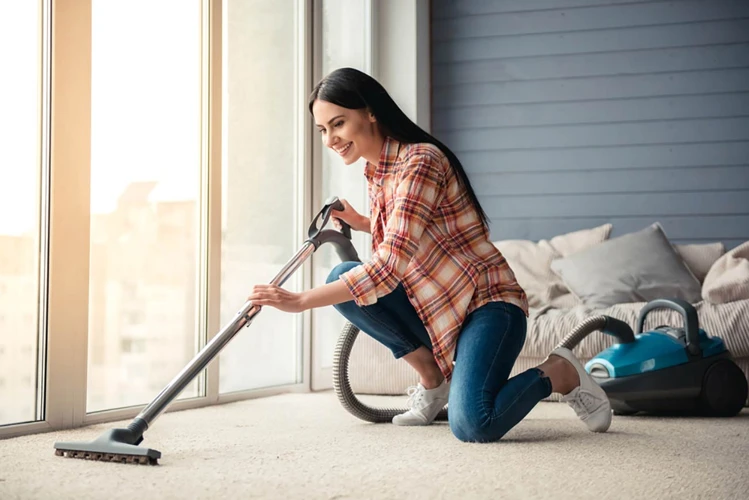
Choosing the right upright vacuum cleaner is an important decision to ensure that your cleaning tasks are achieved efficiently and effectively. With so many models and brands available in the market, it can be overwhelming to select the one that meets your specific needs. Before investing your money in an upright vacuum cleaner, consider the following key factors that will help you make an informed decision. Taking the time to understand these factors will help you choose a model that is not only suitable for your home but gives you the best value for your money.
1. Bagged or Bagless
Choosing between a bagged and a bagless upright vacuum cleaner is a crucial decision that affects the overall performance and maintenance of the appliance. Each type has its own advantages and disadvantages, and your choice may depend on your personal preferences, cleaning needs, and budget. Here are some factors to consider:
| Bagged | Bagless |
|---|---|
| Pros: | Pros: |
| 1. Hygienic disposal of dust and debris, as the bag can be easily removed and thrown away without creating a mess. | 1. Eco-friendly and cost-effective, as you don’t need to buy replacement bags, and you can see the amount of dirt you’re collecting. |
| 2. Consistent suction power, as the bag traps and retains most of the dust particles, preventing clogging and minimizing the risk of allergens and bacteria spreading in the air. | 2. Easy to empty and clean the dustbin, which can be transparent and detachable for convenience. |
| 3. Longer lifespan of the filter and the motor, as the bag acts as a secondary filter, prolonging the functionality of the vacuum cleaner. | 3. Lightweight and compact design, as the absence of the bag reduces the size and weight of the unit, making it easier to maneuver and store. |
| Cons: | Cons: |
| 1. Additional cost and hassle of buying and replacing bags regularly, especially if you have pets or allergies that require frequent cleaning. | 1. Potential mess and exposure to dust and debris while emptying the dustbin, especially if you have sensitivities or respiratory issues. |
| 2. Limited storage capacity and suction power, as the bag can fill up quickly and reduce the airflow, forcing you to replace the bag or clean the filter frequently. | 2. Risk of dust leakage and airflow obstruction, as the filter can get clogged or damaged over time, affecting the performance and quality of the suction. |
| 3. Difficulty of finding compatible bags for older or less popular models, which may require more effort and expense. | 3. Higher upfront cost and energy consumption, as the bagless vacuum cleaner may use more power to generate the same level of suction, and may require more maintenance. |
Ultimately, your choice between a bagged or a bagless upright vacuum cleaner depends on your cleaning habits, budget, and expectations. Consider the pros and cons of each type, and choose the one that suits your needs and preferences the most.
2. Filtration System
The filtration system of an upright vacuum cleaner is an essential factor to consider when purchasing one. It determines the level of air quality inside your home and affects the performance and durability of the vacuum cleaner. Here are some of the things to consider about the filtration system:
- HEPA Filters: HEPA stands for High-Efficiency Particulate Air. These filters can trap tiny airborne particles like dust mites, pet dander, and pollen. HEPA filters are ideal for those who suffer from allergies or have respiratory problems. Make sure to check if the vacuum cleaner has genuine HEPA filters, as some models may claim to have this feature, but in reality, only have HEPA-like filters.
- Multi-stage Filtration: A vacuum cleaner with a multi-stage filtration system can capture more particles and prevent them from being released back into the air. A typical multi-stage filtration system includes a pre-motor filter, a HEPA filter, and a post-motor filter. This type of filtration system ensures that the air is cleaner and healthier to breathe.
- Washable Filters: Some vacuum cleaners have washable filters that you can reuse after cleaning. This saves you money on replacement filters and ensures that the vacuum cleaner continues to perform at its best. However, make sure to follow the manufacturer’s instructions when cleaning the filters, as some may require special treatment or replacement.
- Activated Carbon Filters: Activated Carbon Filters can help in reducing bad odor in your home. These filters trap odor-causing particles, such as smoke or pet odor. If you have pets, this feature can be particularly useful.
- Dustbin Size: Some upright vacuum cleaners come with large dustbins that hold more debris. This means less frequent emptying and less exposure to dust allergens. However, keep in mind that large dustbins could make the vacuum bulky and heavy.
Considering the filtration system is crucial if you want to improve the air quality of your home while effectively cleaning your floors. Always check for the types of filters incorporated in the vacuum cleaner since they determine the efficiency of the cleaner. A vacuum cleaner equipped with a genuine HEPA filter and multiple filtration stages works best in cleaning the air and surfaces in your home.
3. Corded or Cordless
One important factor to consider when choosing an upright vacuum cleaner is whether you want a corded or a cordless model. Both options come with unique advantages that can influence your decision.
Corded:
- Unlimited use time: Since corded vacuums remain plugged into an electrical outlet, you can use them continuously without worrying about battery life or charging breaks, making them ideal for deep cleaning or larger spaces.
- Consistent suction: Corded vacuums usually offer more powerful suction and have a constant flow of electricity, allowing for more thorough cleaning.
- Fewer maintenance costs: As a general rule, corded vacuums are more durable and have fewer parts that can break, meaning there are fewer ongoing maintenance costs when compared to cordless models.
Cordless:
- More portable: Cordless vacuum cleaners do not have any cords or wires, making them lightweight and more maneuverable, so they are easier to use for quick cleanups or maneuvering around furniture or room corners.
- No power outlets required: Because cordless vacuums don’t require a power outlet, you can easily move them between rooms and up or down stairs without the hassle of unplugging and plugging them in again.
- Less noise: Cordless vacuums tend to be quieter than their corded counterparts, making them a better option for use in homes with sleeping babies or pets that tend to be scared by loud vacuum noises.
When deciding between a corded or cordless vacuum cleaner, there is no one-size-fits-all answer. It ultimately comes down to your cleaning needs and preferences. Consider the size of your living space, the types of surfaces you will be cleaning, and the frequency of use when deciding which option is best for you.
4. Weight and Maneuverability
One of the crucial factors to consider when choosing an upright vacuum cleaner is its weight and maneuverability. A lightweight vacuum cleaner is easier to carry and move around the house, especially if you need to clean multiple floors. On the other hand, a heavier vacuum cleaner can be challenging to move and may put a strain on your arms and back.
To make it easier for you to navigate through this factor, here are some essential points to keep in mind:
- Consider the weight: Look for a vacuum cleaner that suits your strength and body build. If you have a petite frame or chronic pain, going for a lightweight option is preferable. Models that weigh around 10-12 pounds may be more comfortable to carry and maneuver compared to heavier ones.
- Check the swivel: A vacuum cleaner with enhanced maneuverability can make your cleaning experience more fluid. Look for models with a swivel head that can quickly move around furniture, corners, and tight spaces without interrupting your cleaning rhythm.
- Look for a comfortable grip: A comfortable grip is essential, as it can make vacuuming for extended periods less tiring. Check the handle, and make sure it is ergonomically designed and fits snugly in your hand.
- Try before you buy: If possible, try the vacuum cleaner before you purchase it. This way, you can get a feel of the weight and maneuverability of the model and see if it suits your cleaning needs.
By keeping these tips in mind, you can select a vacuum cleaner that is comfortable to use, lightweight, and enhances your cleaning experience.
5. Attachments and Features
When choosing an upright vacuum cleaner, it is important to consider the attachments and features that come with it. These accessories can make cleaning much easier and more efficient, as well as improve the overall performance of the vacuum.
Attachments: Many upright vacuum cleaners come with a variety of attachments, including crevice tools, dusting brushes, and upholstery tools. Crevice tools are ideal for cleaning tight spaces like between cushions or in corners. Dusting brushes are great for cleaning delicate surfaces like lampshades or curtains. Upholstery tools are designed to clean furniture without damaging the fabric.
Height adjustment: Most upright vacuum cleaners have height adjustment features that allow you to adjust the vacuum head to match the height of the carpet or flooring you are cleaning. This feature ensures that the vacuum is running at maximum efficiency and sucking up as much dirt and debris as possible.
Headlights: Some upright vacuums come with headlights that illuminate the path in front of the vacuum, making it easier to see dirt and debris.
Bagged or bagless: Upright vacuums can come with either a bagged or bagless system. Bagged vacuums require bags that need to be replaced when they are full, while bagless vacuums have dirt containers that can be emptied and reused. Both systems have their advantages and disadvantages, so it ultimately comes down to personal preference.
Corded or cordless: Corded upright vacuums have a constant source of power, while cordless vacuums run on batteries. Corded vacuums typically have a stronger suction power, while cordless models offer more convenience and portability.
When considering attachments and features of an upright vacuum cleaner, it is important to think about your specific cleaning needs and preferences. Don’t forget to also consider the factors we’ve already discussed, such as the filtration system and weight and maneuverability. By choosing the right upright vacuum cleaner with the right attachments and features, you can enjoy a more efficient and effective cleaning experience.
| Attachments | Height adjustment | Headlights | Bagged or bagless | Corded or cordless |
|---|---|---|---|---|
| Crevice tools | Adjustable height settings | Headlight illumination | Bagless system | Corded vacuum |
| Dusting brushes | Customizable height settings | N/A | Bagged system | Cordless vacuum |
| Upholstery tools | Multiple height settings | N/A |
Tips for Using an Upright Vacuum Cleaner
As you become more familiar with using an upright vacuum cleaner, there are a few tips and tricks you can employ to make the most of its capabilities. By following these simple but effective tips, you can improve your cleaning results and extend the life of your vacuum cleaner. From setting the right height to using the right attachments, here’s what you need to know to get the most out of your upright vacuum cleaner.
1. Set the right height
When using an upright vacuum cleaner, it is important to set the right height for the best cleaning performance. The height of the vacuum cleaner should be adjusted depending on the type of flooring that is being cleaned.
Here are some tips on setting the right height for your upright vacuum cleaner:
- For carpets, set the height so that the vacuum cleaner’s brush roll can agitate the carpet fibers without causing any damage. If the height is set too low, the brush roll will not be able to reach deep enough, and if it’s set too high, it won’t be effective at cleaning the carpet.
- For hardwood floors and other hard surfaces, set the height so that the vacuum cleaner’s brush roll is disengaged or turned off. This will prevent any scratching or damage to the surface.
- For fluffy or high-pile carpets and rugs, adjust the height so that the vacuum cleaner’s brush roll is high enough to avoid getting tangled in the fibers.
Setting the right height will not only help you achieve better cleaning performance, but it will also prevent any damage to your floors and carpets. Make sure to refer to your vacuum cleaner’s user manual to identify the best height settings for different flooring types.
2. Use the right attachments
When using an upright vacuum cleaner, it’s important to use the right attachments for the specific cleaning task at hand. This can help to ensure that you get the best cleaning performance possible and can achieve a cleaner home overall. Here are some of the most common attachments that come with upright vacuum cleaners and what they’re best used for:
| Attachment | Description |
|---|---|
| Crevice tool | This long, narrow attachment is designed for cleaning tight spaces, such as corners, baseboards, and the edges of furniture. |
| Dusting brush | This attachment has soft bristles that help to gently remove dust and dirt from delicate surfaces, such as lampshades, blinds, and upholstery. |
| Upholstery tool | This attachment is designed for cleaning fabric surfaces, such as furniture and curtains. It has a wide, flat head and usually has a fabric strip or brush to help agitate dirt and pet hair. |
| Pet hair tool | As the name suggests, this attachment is designed for removing pet hair from furniture, stairs, and other surfaces. It usually has rubber bristles that help to attract and lift pet hair, and may have a rotating brush for better performance. |
| Extension wand | This long, narrow attachment is useful for cleaning high-up areas, such as ceiling fans, crown molding, and light fixtures. |
Using the right attachment for the job can help you achieve a more thorough clean and can also prolong the lifespan of your vacuum cleaner. Be sure to consult your vacuum’s user manual to learn which attachments are included and how to use them properly. And remember, always switch off and unplug your vacuum before changing attachments.
3. Vacuum in all directions
When using an upright vacuum cleaner, it is important to vacuum in all directions to ensure that you pick up all the dirt and debris. This may seem like an obvious tip, but many people make the mistake of only vacuuming in one direction, which can leave behind some dirt and dust.
Vacuuming in different directions can help:
| Direction | Benefits |
|---|---|
| Forward and Backward | Picks up dirt and dust that is lodged deeply in the carpet fibers |
| Right and Left | Covers the width of the carpet or floor, ensuring complete coverage |
| Diagonal | Picks up dirt and debris that may have been missed in the forward and backward motions |
By vacuuming in all directions, you are able to ensure that you cover every part of the carpet or floor, providing a deep and thorough clean. It also helps to prevent dirt and debris from accumulating in one spot and causing damage to the carpet fibers or floor surface.
So, next time you vacuum your carpet or floor, remember to vacuum in all directions, using both forward and backward, right and left, and diagonal motions for a comprehensive clean.
4. Empty the dustbin/bag regularly
Regularly emptying the dustbin or bag of your upright vacuum cleaner is an important aspect of vacuum maintenance. By doing so, you ensure that the machine is functioning at its optimum level and that the suction power remains strong. Failure to clean out the dustbin or replace the bag frequently can lead to clogs and reduced suction power. Here are some tips on how to properly empty the dustbin or replace the bag in your upright vacuum cleaner:
- Turn off the vacuum: Before removing the dustbin or bag, always make sure that the vacuum cleaner is turned off and unplugged. This reduces the risk of injury while handling the dustbin or bag.
- Remove the dustbin or bag: Depending on the model of your upright vacuum cleaner, the dustbin or bag may be easily accessible or slightly more difficult to remove. Follow the manufacturer’s instructions carefully to avoid damaging the machine.
- Dispose of the collected dirt and debris: Empty the dustbin into a garbage can or replace the bag with a new one. Make sure to dispose of the dirt and debris properly.
- Clean the dustbin or bag: After emptying the dustbin or replacing the bag, take a few minutes to clean the dustbin or bag if necessary. Wipe down the inside of the dustbin or replace any filters in the bag to ensure that the vacuum is functioning properly for the next use.
- Reattach the dustbin or bag: Carefully reattach the dustbin or bag, making sure that it is securely locked in place. Improperly reattaching the dustbin or bag could lead to reduced suction power or even damage to the machine.
By following these simple steps, you can ensure that your upright vacuum cleaner is functioning optimally and that your cleaning tasks are completed efficiently. Remember to empty the dustbin or replace the bag regularly to avoid clogs and reduced suction power.
5. Replace filters and belts regularly
Maintaining your upright vacuum cleaner is important to ensure its longevity, performance, and efficiency. One crucial aspect of maintenance is replacing filters and belts regularly. Over time, filters can become clogged with dirt and debris, reducing the suction power and causing the vacuum cleaner to work harder than necessary. Meanwhile, worn-out belts can cause the brushroll to stop rotating, reducing the cleaning performance on carpets.
Filters should be replaced as per the manufacturer’s instructions or when they appear dirty. Most modern upright vacuum cleaners have at least two filters: a pre-motor filter and a post-motor filter. The pre-motor filter is usually positioned near the dustbin/bag and should be cleaned or replaced every 3-6 months depending on usage. The post-motor filter, on the other hand, is often made of HEPA material and should be replaced every 6-12 months to ensure optimal filtration.
Belts are responsible for connecting the motor to the brushroll, which is responsible for agitating and picking up dirt on carpets. If the belt is loose or worn out, it will cause the brushroll to stop rotating or reduce its speed, reducing the cleaning performance. Most upright vacuum cleaners will require belt replacement every 6-12 months, but this can vary depending on usage and the type of belt used.
To find the right filters and belts for your upright vacuum cleaner, refer to the manufacturer’s instructions or consult with a professional. It’s important to use genuine replacement parts to ensure compatibility and avoid damage to your vacuum cleaner.
Regularly replacing filters and belts is a simple but crucial maintenance task that ensures your upright vacuum cleaner continues to work at its best. Don’t neglect this vital aspect of vacuum cleaner maintenance and enjoy optimal cleaning performance for years to come.
| Component | Recommended Replacement Interval |
|---|---|
| Pre-Motor Filter | Every 3-6 months |
| Post-Motor Filter | Every 6-12 months |
| Belt | Every 6-12 months |
Conclusion
In conclusion, using an upright vacuum cleaner has numerous benefits that make it a valuable addition to any cleaning routine. Its ease of use, better cleaning performance, time-saving capabilities, versatility, and cost-effectiveness set it apart from other types of vacuum cleaners.
However, it is important to consider certain factors when choosing an upright vacuum cleaner, including whether it is bagged or bagless, the filtration system, corded or cordless, weight and maneuverability, and available attachments and features. Taking these factors into account can help you find the best upright vacuum cleaner for your specific needs.
Once you have chosen your upright vacuum cleaner, there are certain tips you can follow to maximize its effectiveness, such as setting the right height, using the right attachments, vacuuming in all directions, regularly emptying the dustbin/bag, and replacing filters and belts as necessary.
Overall, by utilizing the advantages of an upright vacuum cleaner and following the proper maintenance and usage tips, you can achieve a cleaner and healthier living space. So, invest in an upright vacuum cleaner today and experience the benefits for yourself.
Frequently Asked Questions
1. Can an upright vacuum cleaner be used on different surfaces?
Yes, most upright vacuums come with adjustable height settings to use on different floor types.
2. Is an upright vacuum better than a canister vacuum?
It depends on personal preference and cleaning needs. Upright vacuums are better for large carpeted areas, while canister vacuums are better for hard floors and tight spaces.
3. Do I need a separate vacuum for pet hair?
Not necessarily. Many upright vacuums come with specialized pet hair attachments to effectively remove pet hair from carpets and furniture.
4. How often should I replace my vacuum’s filters?
It depends on the manufacturer’s recommendation, but generally every three to six months.
5. Can I vacuum up larger debris like cereal or pet food?
Most upright vacuums come with a crevice tool or wider nozzle attachment for larger debris, but it may not be able to pick up all of it at once.
6. How often should I replace my vacuum’s belt?
It depends on the manufacturer’s recommendation, but generally every six months to a year.
7. Can cordless upright vacuums replace corded ones?
It depends on personal preference and cleaning needs. Cordless vacuums are more convenient but may not have as powerful suction as corded vacuums.
8. Is it necessary to clean my vacuum’s brushroll?
Yes, it is important to remove hair and debris from the brushroll regularly to maintain the vacuum’s suction and prevent damage to the brushroll.
9. Can an upright vacuum reach tight spaces?
Most upright vacuums come with attachments like crevice tools or extension wands to reach tight spaces.
10. How does the filtration system in an upright vacuum work?
Most upright vacuums use a combination of pre-motor and post-motor filters to trap dust and allergens. Some models also have HEPA filters for the highest level of filtration.

